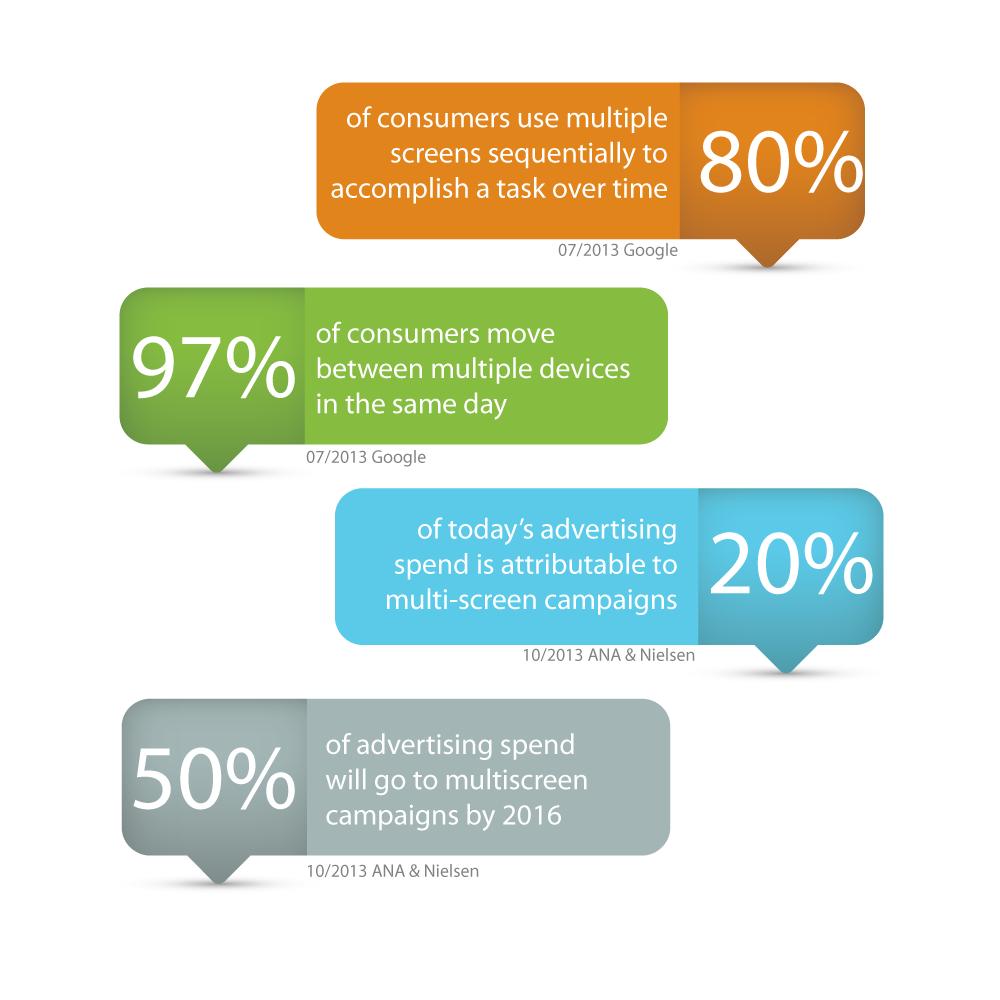Will Measurement Shortfalls Hinder The Growth Of Multi-Screen Marketing?
Mobile is taking over nearly every facet of consumer life as we know it, and there’s no slowing down in sight. The Association of National Advertisers (ANA) and Nielsen recently reported that in just three years’ time, nearly half of all media campaigns are expected to take on multi-screen strategies. In this study and in […]
Mobile is taking over nearly every facet of consumer life as we know it, and there’s no slowing down in sight. The Association of National Advertisers (ANA) and Nielsen recently reported that in just three years’ time, nearly half of all media campaigns are expected to take on multi-screen strategies.
In this study and in most cases, multi-screen campaigns are defined as those that run during a similar timeframe across two or more screens including TV, computer, tablet, mobile phone and digital place-based media.
For most brands, the focus is on giving their audience the right experience at the right time. Ad messages and customer brand experiences on smartphones and tablets differ from those on your desktop and TV.
Dominos is a prime example of a brand that has done a great job of creating multi-screen strategies, some of which include TV ads (video autoplay) that encourage users to place food orders via computers and smartphones. In 2013 alone, the pizza brand made everything from dominoslive.com to Domino’s Pizza Tracker available on mobile.
![]()
AMC’s The Walking Dead (featured in Digiday’s Content Studio earlier this year) is another good example of multi-screen marketing. In the case of The Walking Dead, viewers demonstrate engagement across all screens and through a variety of channels including TV, Facebook, online games and ongoing live trivia, polls and exclusive online videos. This level of engagement really enables fans to become more involved in their media consumption.
If half of all media campaigns actually take on multi-screen strategies in three years, this will truly represent a large growth in innovation as only about 20% of today’s ad campaigns are leveraging multiple screens. However, great innovation is usually accompanied by similarly great challenges, some of which include measurement and attribution.
Multi-Screen Advertising Measurement
Bill Duggan, Vice President of the ANA, says measurement is one of the biggest issues that will influence the growth of multi-screen advertising. According to Nielsen and ANA’s study, 71% of marketers surveyed said they use a variety of metrics specific to individual screens. However, 73% of them prefer to use a universal metric applicable across multiple devices.

Looking at the current multi-screen ecosystem, I’m not sure measurement is actually a sizable barrier that blocks campaigns from winning rapidly growing budgets. Sure, measurement is an obstacle, but the fact that it is a barrier to growth might actually be a misconception.
If we think about it, as mobile usage increases, advertisers will have to show ads on mobile regardless of whether they agree on a measurement standard. Vast space for new impressions will be opened up as a result, prompting all industry players to compete for new, potentially very profitable inventory.
This misconception about growth being hindered about a lack of a measurement standard actually reminds me of display. Measurement was not great in the early days of digital — and arguably even today, it is still far from ideal — yet, as the song goes, the money keeps rolling in.
So, how important is that “universal” metric? Obviously, we all want to be able to do cross-platform, multi-screen measurement on campaigns. But, is the lack of this universal metric really going to prevent dollars from flowing to multi-screen strategies? I think not.
The projections in the ANA/Nielsen report show that we will see close to a doubling of multi-screen campaigns per year for the next three years. This type of growth is fueled by the number of consumers who have multiple devices and move across screens — not by measurement technologies.
This is a classic example of where consumer adoption has outpaced technology. Marketers don’t have time to wait for their “universal metric.” Instead, they need to learn the lay of the multi-screen land, how to tell brand stories across screens and, more importantly, creatively optimize cross-device experiences.
Multi-Screen Advertising Attribution
The next phase in organizing ad messages across screens is attribution. eMarketer highlights that more than 200 million US consumers access media on multiple screens every month. Additionally, Google reported that 98% of US consumers move sequentially across devices each day.
You can’t even begin to measure or optimize your campaigns across screens without a proper attribution model in place. Last-click and last-view simply won’t work for multi-screen strategies. Each device, each screen and each message plays a role in influencing consumers, oftentimes requiring different ad messages and even different metrics. Instead of a universal metric, marketers should instead look to how they can align data to different screens.
I am not saying that the inability to properly measure campaign ROI across screens isn’t a challenge, but I am not sure it will really inhibit growth. The challenge that I see for growth is more of a business issue – where the consumer is ahead of our marketing technology capabilities. Advertisers and technology solutions have to move full steam ahead if they want to catch up to where consumer engagement is taking place.
Contributing authors are invited to create content for MarTech and are chosen for their expertise and contribution to the search community. Our contributors work under the oversight of the editorial staff and contributions are checked for quality and relevance to our readers. MarTech is owned by Semrush. Contributor was not asked to make any direct or indirect mentions of Semrush. The opinions they express are their own.
Related stories